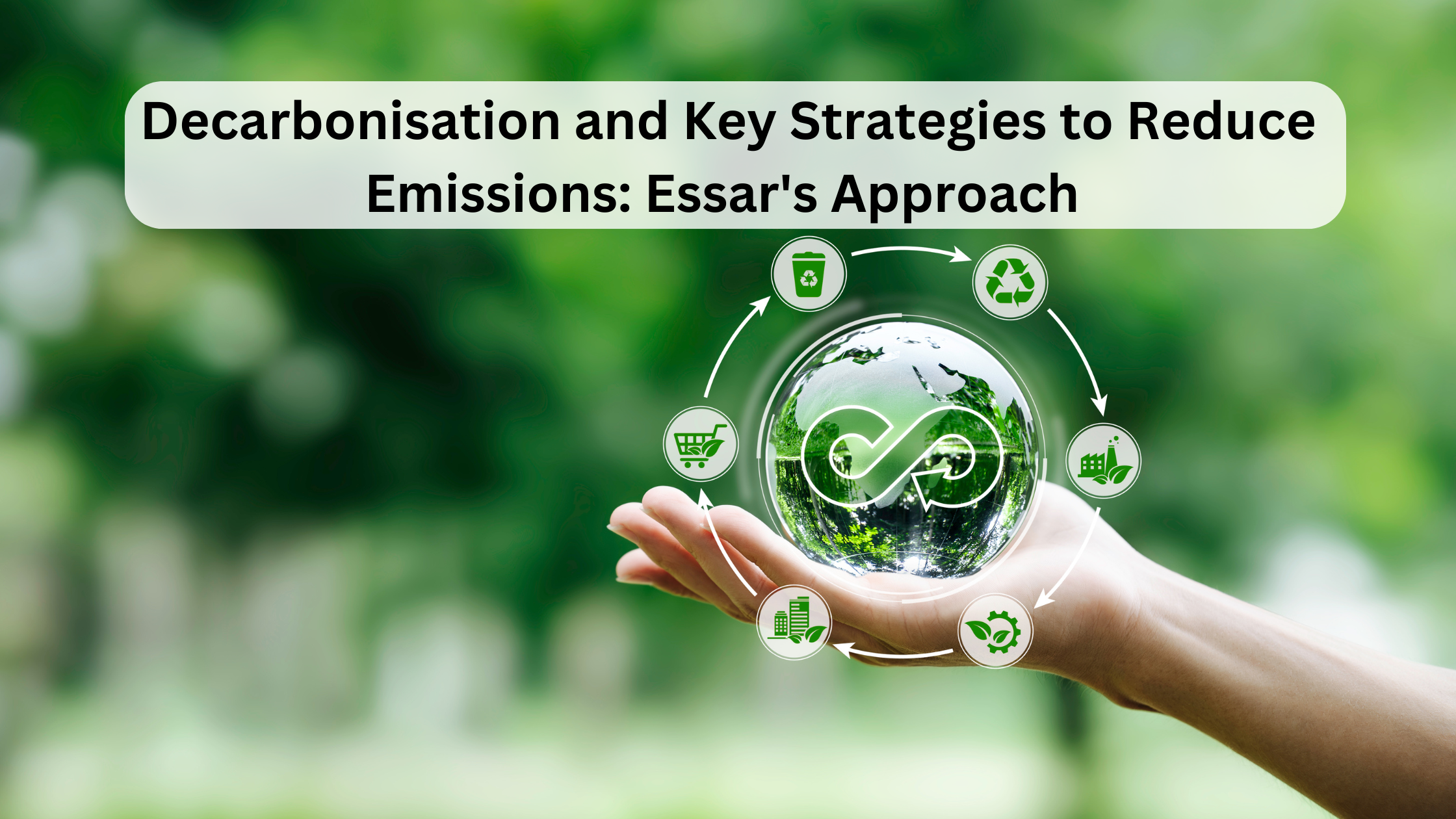
Decarbonisation has become a global priority for governments, businesses, and society as a whole, playing a crucial role in mitigating climate change. Though many companies have declared their commitment to becoming carbon-neutral by 2050, recent estimates by the United Nations (UN) suggest we are not on track to meet the Paris Agreement targets. Thus to reach these ambitious goals, we must come together to achieve sustainability at a greater speed. Today, when the world is focussing on sustainability, the Essar Group has emerged as a leader in this transformation, mainly through its substantial investments in India and overseas.
To combat climate change, some of the world’s largest companies, like Essar Group, have set aggressive decarbonisation strategies to minimize their environmental impact. While media has been highlighting many of Essar crises, the company’s sustainability agenda, and the milestones it has been achieving has not been spoken about much. Last few years, Essar has been transitioning its portfolio, investing in renewable energy sources, enhancing energy efficiency across sectors, green transportation, investing in carbon capture technologies, etc.
In the following blog, we discuss decarbonisation, highlighting the main strategies in 2025 and beyond.
What is Decarbonisation?
Decarbonisation means reducing or eliminating greenhouse gas GHG emissions to achieve a net zero balance. The main agenda behind decarbonisation is to have zero net increase in atmospheric GHG levels, with the ultimate aim of achieving a sustainable, low-carbon economy. Decarbonisation consists of two main strategies, including reducing GHG emissions and capturing carbon from the atmosphere, known as ‘carbon sequestration.’
Main Strategies for Decarbonisation
Considering there is no single way of reducing emissions, businesses like Essar Group have adopted various decarbonisation strategies, from cutting high-carbon processes to investing in renewable energy and carbon capture. Some of the main strategies for decarbonisation include:
Renewable Energy
According to the United Nations Environmental Program (UNEP), fossil fuels contribute to nearly 80% of global carbon emissions. Thus, to minimize carbon emissions, businesses are shifting to renewable energy sources like solar, wind, hydroelectric, biofuels, geothermal, and nuclear. According to Grand View Research, the global renewable energy market size was worth USD 1.21 trillion in 2023 and is expected to grow at a compound annual growth rate (CAGR) of 17.2% from 2024 to 2030. The shift toward low-carbon fuels and the existence of stringent environmental regulations have provided significant momentum in the renewable energy sector.
Essar Group has been at the forefront of this movement, investing in renewable energy to power its operations and reduce its carbon footprint. The group plans to invest INR 30,000 crore in a green hydrogen plant in Jamnagar, Gujarat, over the next four years. The group’s focus will be on clean energy for growth, and this project will use 4.5 GW of renewable energy by its sister concern- Essar Renewables, to split water molecules to produce hydrogen and oxygen. Essar Renewables has a broader plan to set up ~8GW of power capacity through solar and wind.
Greening the Supply Chain
Scope 3 emissions can account for more than 70% of an organisation’s carbon footprint and primarily stem from the supply chain. Managing supply chain emissions or transitioning to cleaner alternatives seem like an overwhelming task, with more companies struggling with limited visibility and perceiving that they have minimal control over reducing their emissions.
Companies urge suppliers to support their decarbonisation goals. In various countries, governments have also taken strict measures by making it mandatory for companies to include carbon reduction plans in tender applications. Thus, organisations that fail to comply are finding it difficult to secure contracts with government bodies and major corporations committed to cutting carbon emissions.
Transportation Mobility
Indeed, the transportation sector is one of the biggest carbon emitters and is gradually transitioning from fossil fuels to electric vehicles (EVs). Low-emission cars are becoming quite common, but heavy-duty vehicles still face challenges. However, the EV charging industry is taking steps to support the electrification of these vehicles, especially for short routes. According to the International Council on Clean Transportation (ICCT), battery-electric trucks could reduce greenhouse gas emissions by up to 63% compared to diesel.
Companies like Essar are transitioning to low-emission vehicles, including electric trucks and LNG-powered trucks, which offer substantial reductions in CO2 emissions and other pollutants. Through GreenLine Mobility Solutions Ltd, Essar’s Green Mobility initiative has introduced LNG-powered trucks to bring significant reductions in toxic emissions compared to diesel. Currently, GreenLine Mobility operates a fleet of more than 500 LNG-powered trucks and plans to have 1,000 such trucks by March 2025. In addition to LNG trucks, the Essar Group plans to introduce EVs for short routes in the future.
Energy Efficient Technologies
Energy inefficiencies, especially in production and building operations, have resulted in substantial waste. To minimize this, businesses are heavily investing in energy-efficient technologies that optimise and reduce electricity use in buildings. By cutting excess supply and saving energy, advanced technologies can significantly reduce carbon footprints.
From using hydraulic fracturing at coal bed methane (CBM) wells to enhance the productivity of the wells to integrating water treatment and management technologies, Essar is consistently working towards minimizing emissions. Additionally, the company is leveraging digitalization, artificial intelligence, and automation to optimize processes, improve operational efficiency, and further reduce its environmental impact.
Carbon Capture and Storage (CCS)
Some industries, particularly the ones with high emissions, may not be able to eliminate their carbon output. CCS captures CO2 emissions before they enter the atmosphere and stores them underground, creating a ‘closed loop’ where carbon is extracted and returned to the Earth.
Essar Group is heavily investing in CCS technology, especially at its UK Stanlow refinery complex. Under its Essar Energy Transition (EET) initiative, Essar aims to achieve 95% decarbonisation of its Stanlow refinery by 2029, using the combination of blue hydrogen production and carbon capture technology. Essar Group is turning the UK’s Stanlow refinery into the world’s first decarbonised refinery by using low-carbon hydrogen to meet the heating and power needs of the unit.
Conclusion
Achieving net zero emissions is not just an obligation for businesses; it’s a transformative opportunity for global companies. With the escalating climate crisis, there is a growing need for organisations to address sustainability by not just meeting regulatory demands but boldly innovating and thriving through strategic decarbonisation. These strategies are no longer mere trends; they are critical actions that lead to substantial reductions in carbon emissions.
Essar Group continues to lead by example in sustainability. From decarbonizing its UK oil refinery to generating renewable round-the-clock power, to creating an LNG and electric ecosystem for trucks to much more, Essar remains the epitome of sustainable business practices. Despite Essar Crises in the past, the company remains steadfast in its vision of building world-class sustainable businesses, creating value for all stakeholders, more so sustainably.







